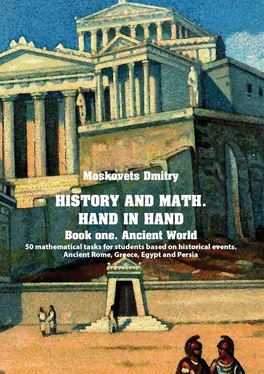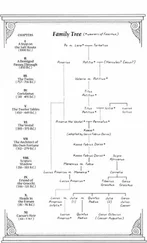R.5. The trophies of Saguntum 29 29 Today, it is a municipality of Spain, Sagunto.
The Second Punic war began in 219 BC when Hannibal 30 30 Hannibal was a Carthaginian general. He is widely regarded as one of the greatest military commanders in history.
sieged Saguntum. His victorious army captured 2,925 pounds of silver.
Hannibal’s army consisted of Nubian horsemen, Spanish infantry, Carthaginian warriors, tribes from southern Spain, and Balearic slingers 31 31 They were hired from the Balearic Islands in the Mediterranean Sea.
. The ratio of their numbers in the army was 1:2 2:1:0.5.
Hannibal made a just decision to divide everything equally between the soldiers. There were 1,000 Balearic slingers in the army. How many asses (ancient Roman currency) did each soldier get? One denarius was worth 10 asses , and one pound is 72 denarii .
R.6. Swift Carthaginian spy
The Roman consul decided to send several triremes to support the armies fighting in Spain, near Massalia, (modern Marseille in France). The fleet was not far from Pompeii 32 32 Pompeii is an ancient city that was buried under volcanic ash and pumice in the eruption of Mount Vesuvius in AD 79.
, and Gannon, a cunning Carthaginian spy, found out about this. To warn Hannibal’s army, he would need to travel faster than the Roman triremes . How quickly does Gannon need to travel by land if the distance between Pompeii and Massalia is 791 km by sea? By land, the spy needs to pass through Rome and Genoa. The distance between Pompeii and Rome is 173 km, from Rome to Genoa – 403 km, and from Genoa to Massalia – 346. The average speed of trireme is 5 km per hour. Well, one cannot always have a tailwind! The spy needs to sleep at least 6 hours a day. Otherwise, he might lose his vigilance and get captured by the valiant Praetorians 33 33 The Praetorian Guard was a unit of the Imperial Roman army that served as personal bodyguards and intelligence agents for the Roman emperors.
.
R.7. The first battle of the Second Punic War
In November 218 BC, Hannibal’s troops approached the Ticinus River. Simultaneously, from Italy, Scipio’s 34 34 Publius Cornelius Scipio was a general and statesman of the Roman Republic. He served as consul in 218 BC, the first year of the Second Punic War.
troops approached the same river. The first battle took place near this place. From Carthage’s side, only its cavalry took part in the battle. However, the Romans used both cavalry and light infantry, velites 35 35 An infantry class in the Roman army.
. Hannibal had 6,000 cavalry units. From the Roman side, the cavalry was 100 units more than half of the Carthaginian forces. Moreover, the infantry was 20% more than Hannibal’s cavalry. In total, how many soldiers took part in the battle?
R.8. The Battle of Trebbia or how to win allies
Конец ознакомительного фрагмента.
Текст предоставлен ООО «ЛитРес».
Прочитайте эту книгу целиком, на ЛитРес.
Безопасно оплатить книгу можно банковской картой Visa, MasterCard, Maestro, со счета мобильного телефона, с платежного терминала, в салоне МТС или Связной, через PayPal, WebMoney, Яндекс.Деньги, QIWI Кошелек, бонусными картами или другим удобным Вам способом.
Khufu was the second pharaoh of the Fourth Dynasty, in the Old Kingdom period. (2589—2566 BC or 2551—2528 BC)
Ramesses II was the third pharaoh of the Nineteenth Dynasty of Egypt that reigned around the 13 century BC.
The Hitties were an Anatolian people that lived in the Bronze Age.
A cubit is a unit of measurement that equals 45 cm.
Alexander III (Alexander the Great, 20/21 July 356 BC – 10 June 323 BC) of the Argead dynasty was a king and a military leader of the ancient Greek kingdom of Macedon, who created one of the largest empires in history that collapsed after his death. During his life, he came to be known as one of the greatest military leaders of all time.
A Royal cubit is a unit of measurement that equals 52.5 cm.
Memphis was an ancient Egyptian city. It existed from the early 3 century BC until the second half of the 1 century AD.
A satrapy is the territory in the Achaemenid Empire governed by a satrap.
A talent was a unit of weight and currency in the ancient times.
Leonidas I was a king of the Greek city-state of Sparta from 491 BC until 480 BC.
Cyrus II was the founder of the Achaemenid Empire, the first Persian empire.
Alexander III (Alexander the Great, 20/21 July 356 BC – 10 June 323 BC) of the Argead dynasty was a king and a military leader of the ancient Greek kingdom of Macedon, who created one of the largest empires in history that collapsed after his death.
This is a very old task. The author found it necessary to mention in his book. He first came across it in a school math club a long time ago and then, in 2014, saw it in a History in Arithmetic in Science and Life .
Pythagoras of Samos (c. 570 BC – c. 495 BC) was an ancient Ionian Greek philosopher and the eponymous founder of Pythagoreanism.
Darius III was the last Achaemenid King of Kings of Persia, reigning from 336 BC to his death in 330 BC.
Let’s assume that the book was published in 2017.
Herodotus was an ancient Greek writer, geographer, and historian.
Pericles (c. 495 BC – 429 BC) was a Greek statesman and general during the Golden Age of Athens. One of the founders of the ancient democracy.
An acropolis was the settlement of an upper part of an ancient Greek city, especially a citadel, and frequently a hill with precipitous sides, mainly chosen for purposes of defense.
Historians debate the truthfulness of this event, as it was mentioned in the documents only five centuries later.
Theseus was the mythical king and founder-hero of Athens. He is sometimes described as the son of Aegeus, King of Athens, and sometimes as the son of the god Poseidon.
In Greek mythology, the Minotaur is a mythical creature portrayed during classical antiquity with the head and tail of a bull and the body of a man. He dwelt at the center of the Labyrinth and was eventually killed by the Athenian hero Theseus.
A quinquereme is a boat with 5 rows of oars, up to 25 rowers in each row and 1 oar per rower. (Displacement – 200 tons, length – 70 m, width – 8 m). It could took up to 100 warriors.
A trireme is a boat with 3 rows of oars, up to 150 rowers, 12 sailors, and 80 warriors.
Читать дальше












